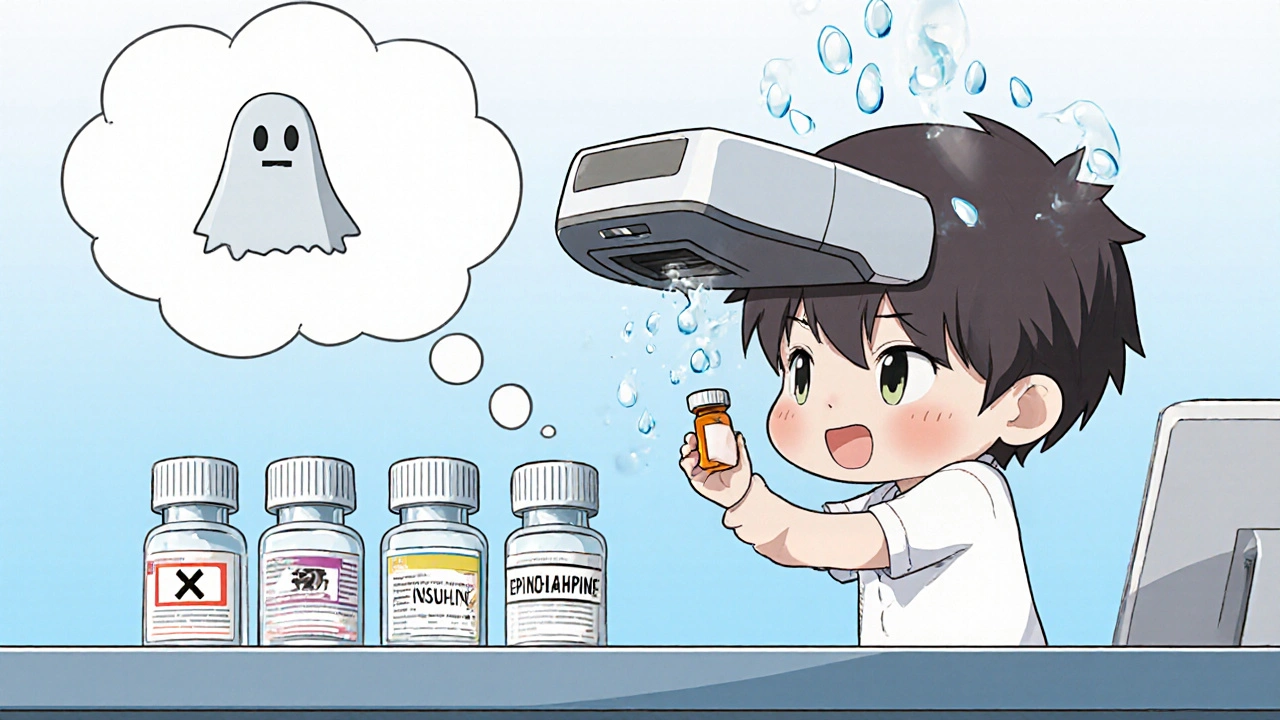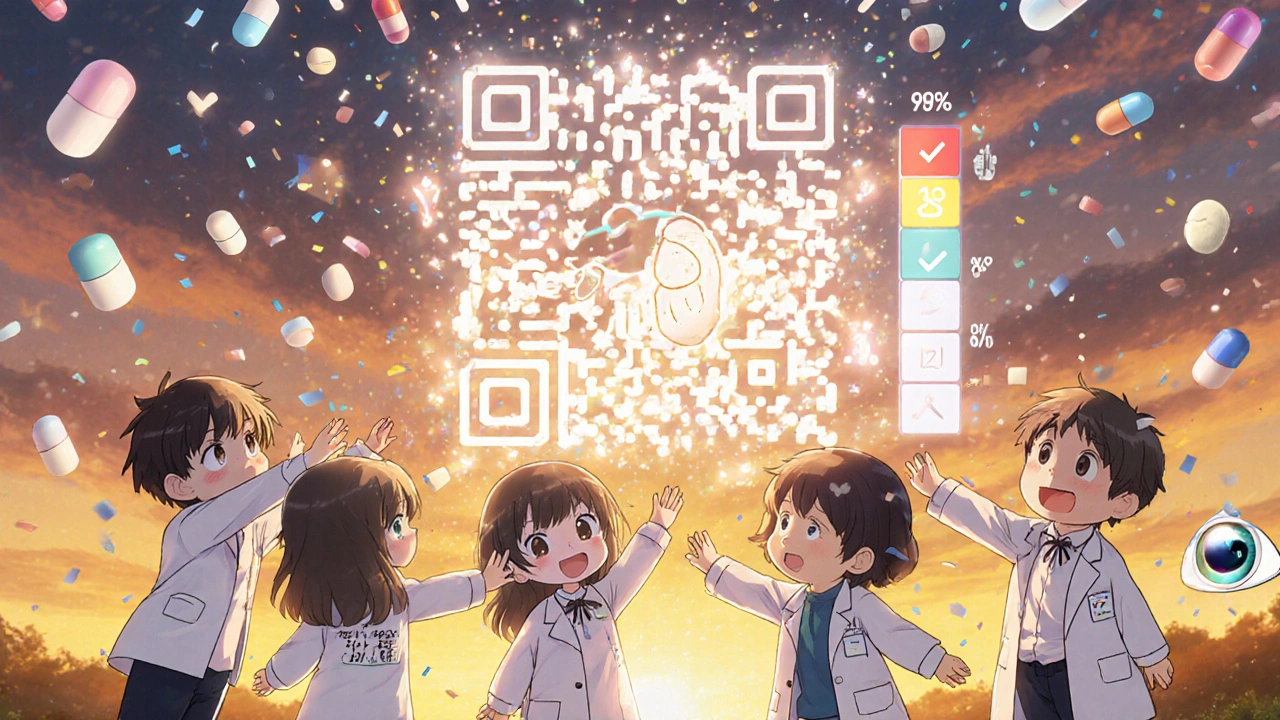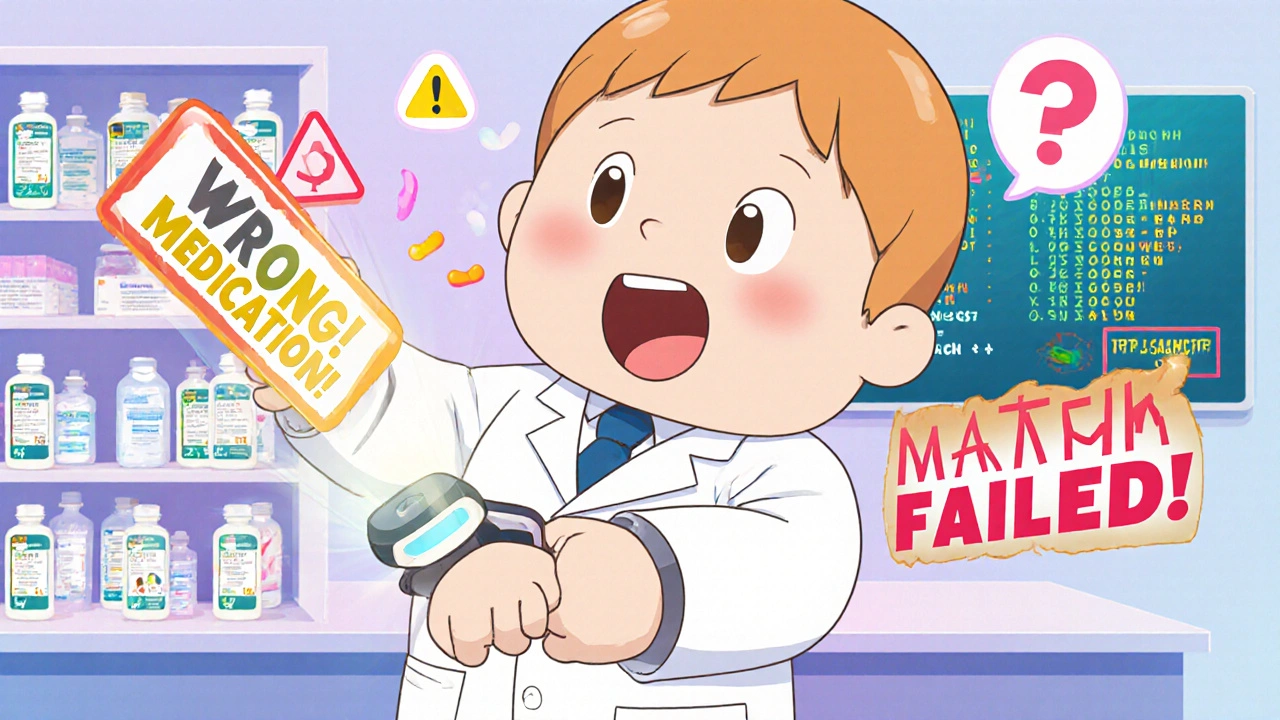Every year, over 1.3 million medication errors happen in U.S. hospitals. Many of these aren’t caused by careless staff-they’re caused by human limits. We forget. We misread. We get interrupted. One wrong pill, one misplaced decimal, and a patient’s life can change forever. That’s where barcode scanning comes in-not as a fancy gadget, but as a lifeline.
How Barcode Scanning Stops Errors Before They Happen
Pharmacies don’t just hand out pills. They verify five critical things: the right patient, the right medication, the right dose, the right route, and the right time. That’s the five rights. Manually checking each one? It’s slow. And humans make mistakes. A 2021 study in BMJ Quality & Safety found that manual double-checks catch only about 36% of errors. Barcode scanning? It catches 93.4%. Here’s how it works. When a pharmacist picks up a medication, they scan the barcode on the package. At the same time, they scan the patient’s wristband. The system instantly compares the two. If the medication doesn’t match the order-for example, if someone grabbed levothyroxine instead of lisinopril-the system flashes a warning. No scan, no release. No guesswork. This isn’t theory. In a Pennsylvania hospital, error rates dropped from 13.5% to just 3% after implementing barcode scanning. That’s not a small improvement. That’s life-saving.The Tech Behind the Safety Net
Most pharmacy barcodes today are 1D linear codes-simple black-and-white stripes that hold the National Drug Code (NDC). That’s the unique identifier assigned by the FDA. Since 2006, every unit-dose package in the U.S. has been required to carry this barcode. But newer systems are moving to 2D matrix codes, like QR codes, which can store more data: lot numbers, expiration dates, even concentration levels. The scanners? They’re rugged, high-resolution devices built to read smudged, faded, or partially torn barcodes. They connect wirelessly to pharmacy information systems (PIS) and electronic health records (EHRs), using secure HL7 interfaces. The whole system runs on standard hospital-grade hardware: a 2GHz processor, 4GB RAM, and encrypted data storage to meet HIPAA rules. What makes it powerful isn’t just the scanner. It’s the integration. The system doesn’t just check the barcode. It pulls up the patient’s full medication history, allergies, renal function, and current prescriptions. If a dose is too high for someone with kidney disease? The system flags it. It doesn’t just prevent the wrong drug-it prevents the wrong dose for the wrong person.What It Stops-And What It Can’t
Barcode scanning is best at catching specific, predictable errors:- Wrong drug: Prevents 89% of incidents
- Wrong dose: Stops 86% of cases
- Wrong patient: Catches 92% of mismatches
- Ampules and small vials-like those used for injectables-often have tiny or damaged barcodes.
- Insulin pens and compounded medications don’t always have standardized packaging.
- Emergency meds, like those used in code blue situations, sometimes bypass scanning entirely.

Why Pharmacists Still Bypass the System
You’d think everyone would love this tech. But here’s the truth: many pharmacists hate it. A 2023 survey of 1,247 pharmacists found 78% said barcode scanning reduced errors. But 63% said it slowed them down. Why? Scanning failures. Damaged barcodes. System freezes. Poor lighting. Insufficient training. One pharmacist on Reddit said scanning adds 15-20 minutes to every shift. Another, from Kaiser Permanente, said they lose 30+ minutes daily troubleshooting insulin pen scanners. In rush hours, some techs just skip the scan. AHRQ found that 68% of hospitals with barcode systems still have staff who routinely bypass them. This isn’t laziness. It’s system failure. When the tool doesn’t work reliably, people adapt. And in healthcare, adaptation can be deadly.Best Practices That Actually Work
Leading pharmacies don’t just install scanners-they redesign their workflow. Here’s what works:- Scan the manufacturer’s barcode, not the pharmacy’s re-label. That’s the original source.
- Use special trays for ampules and small vials. Better angle, better scan.
- Train staff on what to do when a barcode fails. Don’t just scan again. Stop. Look. Verify.
- Review scanning data weekly. Which drugs are most often scanned incorrectly? Fix those first.
- Never allow workarounds without reporting them. If someone skips a scan, document why.
Adoption Rates and Market Trends
In U.S. hospitals with 300+ beds, 92% use barcode scanning. In small community pharmacies? Only 35%. Why the gap? Cost. A full system-scanners, software, integration, training-can run $100,000 or more. For an independent pharmacy, that’s a hard sell. But the market is shifting. The global pharmacy automation market hit $6.2 billion in 2023 and is growing over 10% a year. Epic Systems, Cerner, and Omnicell dominate. Epic’s 2024 update improved scanning success by 22% using mobile devices instead of fixed scanners. The future? 2D barcodes. By 2026, ASHP predicts 65% of medications will use them. They’ll hold more data-like storage requirements, handling instructions, even patient-specific warnings. And AI is coming. Cerner’s 2025 update will use machine learning to predict which barcodes are likely to fail and adjust the scanner’s sensitivity automatically.
Is It Worth It?
Yes. But only if you do it right. Barcode scanning isn’t magic. It doesn’t replace judgment. It doesn’t fix bad labeling. It doesn’t stop every error. But it turns a fragile, error-prone process into a layered safety net. It gives pharmacists a second pair of eyes-24/7. The Pennsylvania hospital that went from 86.5% to 97% accuracy didn’t just buy scanners. They trained staff. They fixed workflows. They made scanning non-negotiable. And they never let a failed scan go uninvestigated. That’s the difference between a tool and a system. Barcode scanning isn’t about technology. It’s about discipline. And in pharmacy, discipline saves lives.What Comes Next?
The next frontier isn’t just scanning-it’s connecting. Imagine a barcode that tells you not just the drug name, but whether the patient is allergic to its filler. Or one that shows if the medication was stored at the right temperature. That’s the goal. RFID and blockchain are being tested, but for now, barcode scanning remains the most proven, cost-effective tool we have. It’s not perfect. But it’s the best we’ve got.Can barcode scanning prevent all medication errors?
No. Barcode scanning prevents about 93% of errors related to wrong drug, dose, or patient-but it can’t catch everything. If a label is incorrectly printed but the barcode matches, the system won’t flag it. Visual verification is still required. It also struggles with non-standard packaging like ampules, compounded meds, or emergency drugs. It’s a powerful layer, but not the only one.
Why do some pharmacists avoid using barcode scanners?
Many report slow workflows, scanner failures with small vials or damaged barcodes, and system freezes during busy times. When scanning takes too long or doesn’t work reliably, staff bypass it out of necessity-not negligence. Training gaps and lack of support for troubleshooting also contribute. A 2023 survey found 52% of pharmacists weren’t properly trained on what to do when a barcode won’t scan.
Are 2D barcodes better than traditional 1D barcodes in pharmacies?
Yes, significantly. 2D matrix codes (like QR codes) can store more data-lot numbers, expiration dates, concentration levels, even storage instructions. They’re also more resilient to damage. While only 22% of medications used 2D barcodes in 2023, ASHP predicts that number will jump to 65% by 2026. They’re the future of medication safety.
Is barcode scanning only used in hospitals?
No, but it’s far less common in community pharmacies. About 78% of U.S. hospitals use it, but only 35% of independent pharmacies do-mainly because of cost. Hospital systems can absorb the $100,000+ investment. Small pharmacies often can’t. That’s changing as prices drop and mobile scanners become more affordable.
What should you do if a barcode won’t scan?
Stop. Don’t force it. Don’t guess. Manually verify the medication against the prescription: check the name, dose, strength, and patient name. Compare the physical drug to the order in the system. If it matches, document the failure and report it to your pharmacy’s barcode validation team. Never send a label without verifying the actual medication. ECRI Institute calls this a non-negotiable safety rule.

8 Comments
Olanrewaju Jeph
Barcode scanning isn’t just a tool-it’s a cultural shift in pharmacy practice. The data speaks for itself: 93.4% error detection versus 36% with manual checks. That’s not incremental improvement; it’s a paradigm shift. And yet, we still see staff bypassing it because of poor implementation, not because the tech is flawed. Training, workflow redesign, and consistent enforcement are non-negotiables. This isn’t about technology-it’s about discipline.
Dalton Adams
Let’s be real-this whole ‘barcode revolution’ is just a Band-Aid on a hemorrhage. You’re telling me we’ve spent billions on scanners but still can’t prevent mislabeled vials? 😒 The real problem is lazy pharmacy techs who don’t understand basic pharmacology. If you can’t tell insulin from epinephrine by sight, maybe you shouldn’t be handling meds at all. And don’t get me started on those ‘2D barcode’ hype cycles-QR codes don’t fix bad labeling. They just make it look fancy. 🤦♂️
Kane Ren
I love how this post highlights the human side of tech. It’s not about the scanner-it’s about giving pharmacists a chance to breathe. Imagine being able to trust the system enough to actually focus on the patient instead of double-checking every pill. That’s the real win. And yeah, the system isn’t perfect-but when it works, it’s like having a silent guardian watching your back. Keep pushing for better workflows. We’re getting there.
Charmaine Barcelon
People are so quick to praise scanners. But what about the fact that 68% of hospitals still have staff skipping scans? That’s not a tech problem-that’s a management failure. And if you’re letting people bypass safety protocols because they’re ‘busy,’ you’re just asking for someone to die. It’s not complicated. Scan. Or don’t dispense. No excuses. Period.
Karla Morales
Let’s analyze the ROI: 92% adoption in large hospitals vs. 35% in community pharmacies. The cost barrier is real-but so is the liability exposure. A single error can cost $1.2M in litigation and reputational damage. The $100K system? That’s a bargain. And with Epic’s 22% improvement via mobile scanners, the ROI is accelerating. Also, AI-driven predictive failure detection in Cerner’s 2025 update? That’s not innovation-that’s inevitability. The future is automated, integrated, and non-negotiable. 📊🤖
Pramod Kumar
Man, this reminds me of how we used to check medicines back home in Kerala-by hand, with a shaky lamp and a tired mind. I remember an old pharmacist who’d whisper the drug names like prayers before handing them out. Barcode scanning? It’s not replacing that. It’s honoring it. Giving the human heart a break so it can still do what matters-care. We don’t need robots. We need systems that let humans be human again.
Brandy Walley
barcodes are just a distraction. everyone knows what lisinopril looks like. why waste time scanning? the real problem is overworked staff and bad training. fix that first. #stopthehype
shreyas yashas
Had a friend who works at a small pharmacy in Mumbai. They got a scanner last year. First week? Every single barcode failed. Took them three weeks to get it right. But now? They’ve cut errors by 70%. The trick wasn’t the scanner-it was the daily 10-minute huddle where they talked about what went wrong. Simple. Human. Real. Tech helps-but only if you’re willing to sit down and listen.